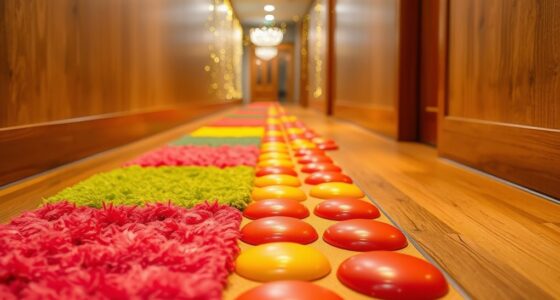To explore warm vs. cold sensations safely, use gentle tools like warm washcloths or chilled cloths wrapped in fabric, always testing temperatures beforehand. Keep activities short and supervise closely to prevent discomfort or injury. Explain each sensation clearly, encouraging your child to express how they feel. Create a calm, cozy environment for these playful experiments, helping your child become more aware of their body’s responses. If you’d like tips on making these sensations even more fun, keep exploring.
Key Takeaways
- Use safe, controlled warm and cold stimuli like washcloths or rice socks, testing temperature beforehand.
- Keep sessions short and closely supervise children to prevent injury or discomfort.
- Explain sensations gently and encourage children to express their feelings to enhance understanding.
- Conduct activities in a cozy environment, making it a fun, shared sensory exploration.
- Monitor children’s cues constantly and stop immediately if signs of discomfort or recoil occur.

Temperature play for kids involves exploring different sensations through safe, controlled exposure to warm and cold stimuli. It’s a way to encourage sensory exploration, helping children understand how their bodies respond to various temperatures. As you introduce these activities, it’s vital to keep safety precautions in mind to guarantee the experience stays positive and injury-free. You want to create an environment where your child feels comfortable, curious, and safe as they discover new sensations.
Start by selecting appropriate tools and materials. For warm sensations, you might use a warm washcloth, a heated rice sock, or a warm water bath. For cold sensations, options include a chilled washcloth, an ice cube wrapped in a cloth, or a cold pack. Always test the temperature yourself before offering it to your child to prevent accidental burns or discomfort. Maintaining a safe temperature range is essential—avoid anything too hot or too cold that could cause pain or injury. Keep the stimuli at a mild, tolerable level, and watch your child’s cues closely. If they show signs of discomfort or recoil, it’s your signal to stop and reassess.
As you introduce these stimuli, explain what you’re doing so your child understands the purpose of the activity. Use gentle language and encourage them to describe how each sensation feels. This not only promotes sensory exploration but also helps build their vocabulary and confidence in expressing feelings. Keep the sessions short—just a few minutes at a time—and always supervise closely. Never leave your child unattended with any temperature-controlled items, especially ice or hot objects, to prevent accidents.
Incorporate these activities into a calm, relaxed environment. You might sit together on a cozy blanket or a comfortable chair, making the experience feel like a fun, shared experiment. Encourage your child to compare sensations—what does warm feel like compared to cold? How does their body react? This helps them develop a greater awareness of their own sensory responses. Remember, the goal is for them to enjoy discovering new feelings safely, not to push beyond their comfort zone.
Frequently Asked Questions
How Do I Ensure Safety During Temperature Play Experiments?
To guarantee safety during temperature play experiments, you should always follow safety precautions like testing temperature beforehand and using safe, controlled sources of warmth or cold. Keep close supervision strategies in place, constantly monitoring your child’s reactions and maintaining a safe environment. Never leave them unattended with temperature sources, and teach them about boundaries and how to recognize discomfort. This approach helps prevent accidents and ensures a fun, safe experience.
Can Temperature Play Be Incorporated Into Classroom Science Lessons?
Yes, you can incorporate temperature play into classroom science lessons by exploring thermal conduction and heat transfer. You might demonstrate how different materials conduct heat or cold, using safe, supervised experiments like touching metals versus plastics. Encourage students to observe how heat moves between objects, fostering curiosity about thermal conduction. Always prioritize safety, ensuring temperatures stay within safe limits and explaining the science clearly to enhance understanding.
Are There Age Restrictions for Children Participating in Temperature Experiments?
You should prioritize age-appropriate experiments and guarantee parental supervision for children participating in temperature experiments. Young kids might find cold or warm items overwhelming, so tailor activities to their developmental level. Always stay present and attentive, guiding them safely through each step. By doing so, you help them explore safely while fostering curiosity without exposing them to unnecessary risks or discomfort.
What Common Household Items Can Be Used for Temperature Play?
Think of household items like spoons, towels, or ice cubes as your toolkit for temperature play. You can use warm water in a bowl or chilled items like frozen peas to explore sensations. Just remember, safety precautions are key: test temperatures first, avoid direct contact with extreme heat or cold, and supervise your kids closely. With these simple items and precautions, you can turn everyday moments into fun, educational experiments.
How Can I Explain the Science Behind Temperature Changes to Kids?
You can explain the science behind temperature changes by showing how thermodynamics principles work. Use simple heat transfer methods like conduction, convection, and radiation to illustrate how heat moves from warm to cold objects. For example, touch a warm object and feel how heat transfers through conduction. Explain that heat always moves from hotter to cooler areas, helping kids understand the basic science behind temperature changes easily.
Conclusion
Now that you’ve explored warm and cold experiments, you’ve unsealed a world of sensory discovery. Just like a curious explorer, you can continue to investigate how temperature affects everything around you. Remember, these experiments aren’t just about heat or chill—they’re about igniting your curiosity and embracing the wonder in everyday things. So go ahead, keep experimenting, and let your curiosity be the compass that guides you through the fascinating world of temperature play.









